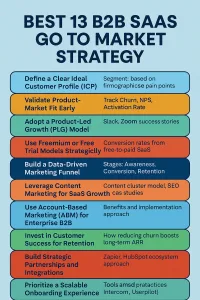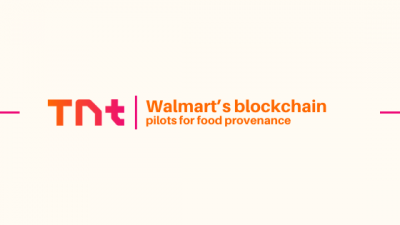Best 13 B2B SaaS Go To Market Strategy for 2025
According to a recent SaaS industry report, over 70% of SaaS startups fail due to poor market alignment or lack of a GTM plan. That’s why understanding and implementing the right SaaS GTM strategy can mean the difference between success and stagnation.
In this guide, we’ll explore 13 of the best B2B SaaS Go To Market strategies that have driven growth for industry leaders like HubSpot, Slack, and Zoom and how you can use them to accelerate your own success.
What is a B2B SaaS Go To Market Strategy?
A B2B SaaS Go To Market Strategy (GTM) is a structured plan that defines how your product reaches its target audience and converts them into paying customers. It’s not just about marketing — it aligns product positioning, pricing, sales processes, customer onboarding, and retention tactics into one unified growth engine.
Unlike traditional GTM models, SaaS GTM strategies focus on recurring revenue and long-term customer success. You’re not selling a one-time product; you’re selling an ongoing solution.
Key GTM components include:
- Target audience & Ideal Customer Profile (ICP)
- Value proposition
- Marketing & distribution channels
- Pricing & packaging
- Customer success processes
Why a SaaS GTM Strategy Matters for B2B Companies
Without a well-defined GTM strategy, even the best product will struggle. B2B SaaS marketing agencies operate in markets with long sales cycles, multiple stakeholders, and complex decision-making.
A strong go to market strategy for B2B SaaS:
- Reduces customer acquisition cost (CAC)
- Increases conversion rates and retention
- Aligns marketing, product, and sales teams
- Enables scalable and predictable growth
 Stat Insight: SaaS companies with a structured GTM framework experience 34% faster ARR growth compared to those without one (source: SaaStr Annual Report 2024).
Stat Insight: SaaS companies with a structured GTM framework experience 34% faster ARR growth compared to those without one (source: SaaStr Annual Report 2024).
13 Proven B2B SaaS Go To Market Strategies

Below are 13 tested strategies that will help your B2B SaaS business thrive in 2025 and beyond.
1. Define a Clear Ideal Customer Profile (ICP)
Every effective SaaS GTM strategy starts with knowing exactly who you’re selling to.
An ICP (Ideal Customer Profile) defines your target company’s industry, size, revenue, pain points, and decision-makers. This helps tailor your messaging, pricing, and sales approach.
Example: If your SaaS tool automates HR reporting, your ICP could be HR teams in tech startups with 50–200 employees.
Tip: Use CRM and analytics tools to segment your customer base and find patterns in your most profitable users.
- Validate Product-Market Fit Early
No GTM strategy can succeed without product-market fit. Use early adopters to validate your product’s relevance and value.
Measure:
- Churn rate (keep it below 5%)
- Activation rate (the % of users reaching a key milestone)
- Net Promoter Score (NPS)
 Slack pivoted its internal chat tool into a billion-dollar product only after strong PMF signals.
Slack pivoted its internal chat tool into a billion-dollar product only after strong PMF signals.
3. Adopt a Product-Led Growth (PLG) Model
Product-Led Growth empowers your product to sell itself. Instead of relying on aggressive sales tactics, you let users experience value first.
Companies like Notion, Zoom, and Canva use PLG effectively — offering instant value through intuitive onboarding and viral sharing.
PLG works best when your product:
- Solves a clear pain point
- Offers quick wins during onboarding
- Has shareable or collaborative features
4. Use Freemium or Free Trial Models Strategically
The freemium model has become a SaaS staple — but success depends on execution.
Offer limited features for free to drive adoption and upsell premium plans based on usage or advanced features.
Example: Dropbox increased signups by 60% after introducing a free plan with referral bonuses.
Track conversion rates from free to paid to refine your pricing model.
5. Build a Data-Driven Marketing Funnel
Data should guide every stage of your marketing funnel — from awareness to retention.
- Top of funnel (ToFu): Blog posts, SEO, social media
- Middle (MoFu): Case studies, webinars, demos
- Bottom (BoFu): Customer success stories, testimonials
Use marketing automation and analytics to measure touchpoints and optimize accordingly.
6. Leverage Content Marketing for SaaS Growth
Content isn’t just for SEO — it’s your credibility engine.
Create educational, problem-solving content around your niche. Use cluster content to rank for long-tail terms like “B2B SaaS go to market strategy” or “SaaS GTM strategy for startups.”
If you’re unsure where to start, partnering with the best SaaS marketing agency can help you design a data-driven strategy that drives inbound leads and builds authority.
7. Use Account-Based Marketing (ABM) for Enterprise B2B
For high-value B2B deals, ABM is a must. Instead of broad targeting, focus on key accounts that fit your ICP and personalize outreach.
Steps:
- Identify target companies
- Map decision-makers
- Customize campaigns (emails, LinkedIn, webinars)
ABM helps align sales and marketing for faster conversions and higher ROI.
8. Invest in Customer Success for Retention
In SaaS, retention is revenue. A great onboarding and support system reduces churn and boosts lifetime value (LTV).
Implement:
- In-app guides and chat support
- Regular QBRs (Quarterly Business Reviews)
- Customer feedback loops
 Bain & Company found that increasing retention by 5% can boost profits by up to 95%.
Bain & Company found that increasing retention by 5% can boost profits by up to 95%.
9. Build Strategic Partnerships and Integrations
Partnerships expand reach without extra ad spend.
Integrate with complementary tools your customers already use (e.g., Slack, HubSpot, Zapier).
This strategy increases visibility and adds value through interoperability, a win-win for both brands and users.
10. Prioritize a Scalable Onboarding Experience
User onboarding can make or break retention.
- Keep sign-up simple
- Show value fast (interactive tutorials, tooltips)
- Use behavioral emails to re-engage inactive users
Tools like Intercom or Userpilot can automate and personalize the onboarding journey at scale.
11. Use Micro SaaS Ideas for Niche Domination
Micro SaaS is one of the hottest 2025 trends. It focuses on solving niche problems for small audiences with low costs and high margins.
For example, a tool that automates LinkedIn banner design for freelancers can dominate a micro market.
Explore profitable micro SaaS ideas to launch a lean, targeted product and achieve faster ROI.
12. Develop a Strong Sales Enablement Process
Empower your sales team with content, data, and automation tools.
- Build a sales playbook aligned with buyer journeys
- Equip reps with case studies and product decks
- Use CRM analytics to personalize outreach
When sales and marketing are aligned, B2B SaaS companies achieve 67% higher deal closures.
13. Measure, Analyze, and Iterate Constantly
The best GTM strategies evolve.
Track performance metrics:
- CAC (Customer Acquisition Cost)
- LTV (Lifetime Value)
- ARR (Annual Recurring Revenue)
- Activation & retention rates
Use dashboards and feedback loops to refine your strategy monthly or quarterly.
How to Choose the Right Go To Market Strategy for Your SaaS
Your ideal GTM strategy depends on your stage and audience.
- Early-stage: Focus on PLG and inbound marketing
- Growth stage: Add ABM, sales enablement, partnerships
- Enterprise scale: Optimize retention and upselling
Align your GTM framework with your goals, budget, and team capacity.
Common Mistakes in SaaS GTM Strategy and How to Avoid Them
- Ignoring customer research — Guessing your ICP leads to wasted resources.
- Focusing too much on acquisition — Retention is equally crucial.
- Unclear messaging — Confused users don’t convert.
- Overcomplicating onboarding — Simplicity improves activation.
Avoid these pitfalls by keeping your GTM data-driven and customer-centric.
Future of B2B SaaS GTM: 2025 Trends to Watch
- AI-Powered Personalization: Predict customer needs with machine learning.
- Community-Led Growth: Build active customer communities.
- Micro SaaS Expansion: More niche-focused SaaS products gaining traction.
- No-Code Integrations: Easier adoption and customization for users.
The future of B2B SaaS growth lies in personalization, automation, and customer success.
Conclusion
A successful B2B SaaS Go To Market Strategy is the foundation for sustainable growth. From defining your ICP to leveraging PLG and micro SaaS models, every tactic in this list helps you attract, convert, and retain customers more effectively.
As the SaaS ecosystem evolves, brands that analyze, iterate, and adapt their GTM strategy will dominate.
If you want to fast-track your growth, partnering with the best SaaS marketing agency can help you execute these strategies with precision and impact.
Media Contact:
Courtney Wasserburger
CEO, Right Left Agency
Email: [email protected]
Location: Boston, United States.
Website: rightleftagency.com
FAQs
Q1: What is a B2B SaaS Go To Market Strategy?
A B2B SaaS Go To Market Strategy defines how a software company reaches, converts, and retains customers through aligned marketing, sales, and customer success activities.
Q2: How do you create a SaaS GTM strategy?
Start by identifying your target audience, validating your product-market fit, selecting acquisition channels, and building retention and upselling processes around customer feedback.
Q3: What are common mistakes in SaaS GTM?
Skipping audience research, ignoring churn metrics, and misaligned sales-marketing efforts often lead to low conversions and wasted ad spend.
Q4: What is a Micro SaaS strategy?
A Micro SaaS strategy focuses on niche markets, solving very specific problems with lean products. Explore profitable micro SaaS ideas to build focused, high-margin solutions.
Information contained on this page is provided by an independent third-party content provider. Binary News Network and this Site make no warranties or representations in connection therewith. If you are affiliated with this page and would like it removed please contact [email protected]




Comments